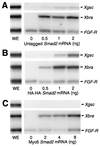A quantitative analysis of signal transduction from activin receptor to nucleus and its relevance to morphogen gradient interpretation
- PMID: 10359791
- PMCID: PMC21994
- DOI: 10.1073/pnas.96.12.6791
A quantitative analysis of signal transduction from activin receptor to nucleus and its relevance to morphogen gradient interpretation
Abstract
Previous work has shown that Xenopus blastula cells sense activin concentration by assessing the absolute number of occupied receptors per cell (100 and 300 molecules of bound activin activate Xbra and Xgsc transcription, respectively; a difference of only 3-fold). We now ask how quantitative differences in the absolute number of occupied receptors lead to the qualitatively distinct gene responses in the nucleus through SMAD2, a transducer of concentration-dependent gene responses to activin. We show that the injection of 0.2 or 0.6 ng of Smad2 mRNA activates Xbra or Xgsc transcription, respectively, involving, again, only a 3-fold difference. Furthermore, Xbra transcription is down-regulated by overexpression of SMAD2 as it is after activin signaling. We have developed a method to isolate nuclei from animal cap cells and subsequently have quantified the amount of nuclear SMAD2 protein. We find that the injection of 0.2 or 0.6 ng of Smad2 mRNA into an egg leads to only a 3-fold difference in the amount of SMAD2 protein in the nuclei of the blastula cells that express Xbra or Xgsc. We conclude that a 3-fold difference in the absolute number of occupied activin receptors can be maintained only as a 3-fold difference in the level of nuclear SMAD2 protein. Therefore, in this example of morphogen action, there appears to be no amplification of a key cytoplasmic transduction response, and a small but developmentally important change in extracellular signal concentration is relayed directly to the nucleus.
Figures





References
Publication types
MeSH terms
Substances
LinkOut - more resources
Full Text Sources
Other Literature Sources
Miscellaneous

